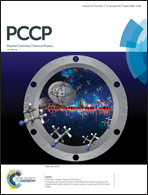Photochemical behavior of biosupramolecular assemblies of photosensitizers, cucurbit[n]urils and albumins†
Abstract
Biosupramolecular assemblies combining cucurbit[n]urils (CB[n]s) and proteins for the targeted delivery of drugs have the potential to improve the photoactivity of photosensitizers used in the photodynamic therapy of cancer. Understanding the complexity of these systems and how it affects the properties of photosensitizers is the focus of this work. We used acridine orange (AO+) as a model photosensitizer and compared it with methylene blue (MB+) and a cationic porphyrin (TMPyP4+). Encapsulation of the photosensitizers into CB[n]s (n = 7, 8) modified their photoactivity. In particular, for AO+, the photo-oxidation of HSA was enhanced in the presence of CB[7]; meanwhile it was decreased when included into CB[8]. Accordingly, peroxide generation and protein fragmentation were also increased when AO+ was encapsulated into CB[7]. The triplet excited state lifetimes of all the photosensitizers were lengthened by their encapsulation into CB[n]s, while the singlet oxygen quantum yield was enhanced only for AO+ and TMPyP4+, but it decreased for MB+. The results obtained in this work prompt the necessity of further investigating these kinds of hybrid assemblies as drug delivery systems because of their possible applications in biomedicine.
![Graphical abstract: Photochemical behavior of biosupramolecular assemblies of photosensitizers, cucurbit[n]urils and albumins](/en/Image/Get?imageInfo.ImageType=GA&imageInfo.ImageIdentifier.ManuscriptID=C6CP07749H&imageInfo.ImageIdentifier.Year=2017)


 Please wait while we load your content...
Please wait while we load your content...